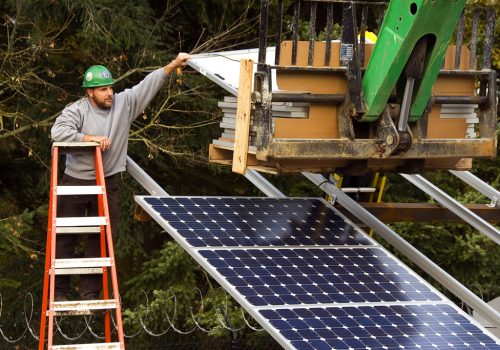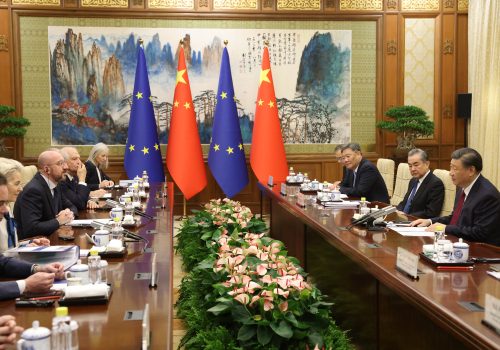The IRA and CHIPS Act are supercharging US manufacturing construction
Last April, at a speech at the Brookings Institution, US National Security Advisor Jake Sullivan stated: “We will unapologetically pursue our industrial strategy at home, but we are unambiguously committed to not leaving our friends behind.” Nearly one year later, it is clear the Biden Administration is following through—at least with the first half of his promise. In 2023, US construction spending on new manufacturing facilities more than doubled compared with 2022. Companies spent, on average, $16.2 billion dollars a month building new production facilities. Backed by a once-in-a-generation investment in domestic manufacturing through the Biden administration’s Infrastructure Investment and Jobs Act (IIJA), Inflation Reduction Act (IRA), and CHIPS and Science Act, companies across the United States are taking advantage of the administration’s unapologetic approach to industrial policy and reshoring. However, with the combined costs of the administration’s “Modern Supply-Side Economics policy framework” likely topping four trillion dollars, even Washington’s wealthiest allies and partners will have trouble matching its scope.
While the United States is well on its way to building the next generation of facilities to produce the integrated circuits, solar panels, and batteries needed to supply its digital and green transitions, the EU is struggling to connect its companies with state financing. In theory, the EU’s 27 members have matched US efforts through the European Commission with the NextGen EU recovery fund, a debt-funded program worth around $880 billion. However, because the commission lacks a permanent fiscal union with centralized taxation and borrowing powers, it has had to rely on member states to design and implement plans for NextGen funds. This decentralized approach, in conjunction with stipulations attached to its disbursements, have made it far harder for EU companies to access funding.
NextGen EU funds are contingent on governments meeting performance targets set by the Commission. As of early 2024 just 18 percent of the Commission’s targets have been met, meaning that only about 30 percent of available grants and loans have been released to member states. Some member states, such as Poland and Hungary, have been blocked from accessing a bulk of their allocation because of the Commission’s rule-of-law concerns. Others, like Germany, have been stopped by their own constitutional court from releasing the funds to industry. These funding lags and uncertainties have stymied EU manufacturers’ investment at home. In contrast, the scale and accessibility of funding in the United States has meant that some major European manufacturers such as Volkswagen, BMW, Enel, and Norwegian battery group Freyr, are opting to instead prioritize investments in the United States.
What’s driving the US manufacturing construction boom
In line with IRA and CHIPS and Science Act priorities, construction is overwhelmingly concentrated in the computer, electronics, and electrical manufacturing sectors. This broad sector covers manufacturers producing computers, communications equipment, similar electronic products, as well as products that generate, distribute, and use electrical power. In other words, the goods needed to facilitate the green and digital transitions. Since the start of 2022, spending on construction for this sector has approximately quadrupled.
This surge in spending has transformed the computer and electronic segment into the dominant driver of US manufacturing construction. In 2023, the sector contributed some 64 percent of all construction manufacturing spending. Just five years earlier, its share stood at a meager 11 percent. The growth in computer and electronic manufacturing has not come at the expense of other sectors. Chemical and transportation manufacturing construction spending is also up 4 and 21 percent respectively from 2022 to 2023, and food and beverage manufacturing construction spending has remained steady.
While this historic expansion in US manufacturing construction is the first step to the reshoring of domestic production, concerns remain over whether the framework will be able to deliver the manufactured products. Labor force bottlenecks remain as the most immediate risk to the Biden Administration’s success. The US Bureau of Labor Statistics’s Job Openings and Labor Turnover Survey (JOLTS) notes that there were 601K open manufacturing jobs and 449K open construction jobs in December 2023. With US unemployment currently sitting at 3.7 percent, well below the average rate of 5.8 percent of the past two decades, the Biden administration’s main challenge will be to find workers to build and staff these new manufacturing facilities. One way to do this will be to support the transition of workers away from declining industries through the upskilling domestic workers. However, this alone will likely be insufficient. The US will also need to bring in skilled workers from abroad through reforms of its immigration system.
With US industrial policy implementation well underway, the White House should now shift attention toward how it can best bring along the US’ allies and partners. Delays around NextGen EU, the elevated energy costs and economic uncertainty stemming from Russia’s invasion of Ukraine, and structural differences between the the US and EU’s governance structure mean that the Commission will not be able to galvanize investments in manufacturing production facilities at the same scale or speed as the United States. This is further complicated by the EU’s surging green goods imports originating from China as Beijing attempts to export its production overcapacity abroad. If Washington wants to ensure the European green and digital transition is built by friendly manufacturers, it should aim to do more to directly support its partners in Brussels, Berlin, and beyond.
Niels Graham is an associate director for the Atlantic Council GeoEconomics Center where he supports the center’s work on China’s economy and US economic policy.

At the intersection of economics, finance, and foreign policy, the GeoEconomics Center is a translation hub with the goal of helping shape a better global economic future.
Further reading
Tue, Aug 8, 2023
To deliver on IRA objectives, expand the clean energy workforce
EnergySource By Paddy Ryan, Maia Sparkman
Upskilling and growing the US labor force for the clean energy transition is a must for delivering the economic and climate objectives of the Inflation Reduction Act.
Mon, Dec 11, 2023
China’s manufacturing overcapacity threatens global green goods trade
Econographics By Niels Graham
Chinese lending is exacerbating a growing glut in its green manufacturing sector. Beijing is increasingly looking abroad to absorb excess capacity. This may have devastating effects for the global trading system as economies move to protect their own domestic industry.
Tue, Jan 30, 2024
Gina Raimondo and Margrethe Vestager on transatlantic approaches to trade, AI, and China
Transcript By
The US commerce secretary and European Commission executive vice president discussed transatlantic trade and technology cooperation at the Atlantic Council.
Image: Canoo technicians work on battery packs for Canoo electric vehicles at a manufacturing site in Livonia, Michigan, U.S. November 29, 2022. REUTERS/Rebecca Cook


